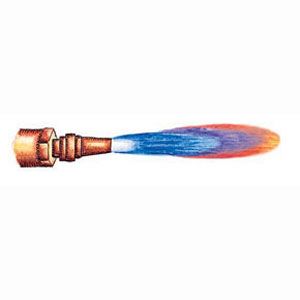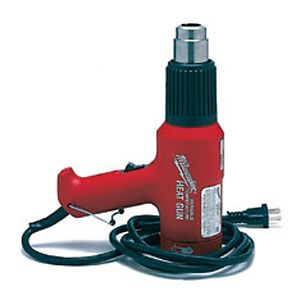Heat tools can soften old paint, thaw frozen locks, solder electrical and plumbing connections, or even weld iron. The key to effectively using heat tools is to match the right heat output to the right task. A handheld propane torch is suitable for most household tasks.
This guide describes the different types of heat tools and their uses for home improvement tasks.
Heat Tool Safety
Always wear appropriate protective gear when working with heat tools, including:
- Safety goggles
- Heat-resistant gloves
- Non-flammable clothing.
Work in a well-ventilated area and keep a fire extinguisher nearby. When using gas-powered torches, check for leaks before ignition and never leave a lit torch unattended.
Types of Heat Tools
There are several types of heat tools available for home improvement projects: torches, heat guns, and soldering irons.
Torches

Torches use gas as fuel to produce flame.
- Propane torches are ideal for soldering copper pipes, brazing, and heating frozen pipes and rusted nuts.
- Oxygen-fuel torches use MAPP (methylacetylene-propadiene) or propane gas. They are suitable for cutting and welding iron and steel but don’t produce as sharp and efficient a flame as oxy-acetylene torches.
- Oxygen-acetylene torches are the most powerful option, capable of brazing, cutting, and welding steel. However, they require more skill and safety precautions to use effectively. Do not use this type of torch without training.
Heat Guns

Electric heat guns produce a concentrated stream of hot air. They’re excellent for softening old paint, putty, and asphalt tiles, as well as heat-shrinking plastic films and electrical tubing. Some models can be used for soldering with special attachments.
Soldering Irons
Soldering irons come in two main styles: pencil-style irons and soldering guns.
- Pencil-style irons take longer to heat up but are less expensive.
- Soldering guns offer quicker heating and more power. Both types are effective for soldering electrical connections and other small-scale applications.
Match Heat Output to Your Task
Select the right tool and heat level for your project and start with the lowest effective temperature. Increase temperature as needed to avoid damaging materials.
| Level | Temperatures (Fahrenheit) | What It’s Best For | Tool Needed | ||||||||||||||||||||||
|---|---|---|---|---|---|---|---|---|---|---|---|---|---|---|---|---|---|---|---|---|---|---|---|---|---|
| Hot | 200-400 degrees | Softening paint and putty | Heat gun | ||||||||||||||||||||||
| 350-840 degrees | Soldering: joining metals with a low-temperature metal filler | Soldering iron | |||||||||||||||||||||||
| Hotter | 840-1,500 degrees | Brazing, soldering with hard filler | Propane torch | ||||||||||||||||||||||
| 1,300-1,600 degrees | Cutting steel | Oxygen-acetylene torch | |||||||||||||||||||||||
| Hottest | 1,250-2,800 degrees | Welding: melting metals (typically aluminum, iron, or steel) together | Oxygen-acetylene torch | ||||||||||||||||||||||
| Level | Temperatures (Fahrenheit) | What It’s Best For | Tool Needed |
Additional Heat Tool Considerations
When working with heat tools, especially torches, ensure you are in a well-ventilated area. Fumes from certain materials can be toxic, and proper airflow helps dissipate potentially harmful gases.
Tool Maintenance
Regular maintenance of your heat tools ensures they function correctly and safely. Check for signs of wear, clean the tools after each use, and replace any damaged parts promptly.
Choosing the Right Fuel
Different torches require specific types of fuel. Ensure you are using the correct fuel for your torch to maintain efficiency and safety. For example, propane is commonly used for general household tasks, while oxy-acetylene is necessary for more intensive welding jobs.
When to Call an Expert
When considering whether to undertake a project involving heat tools on your own or to hire a professional, several factors come into play, including the complexity of the task, your skill level, and safety concerns.
Simple tasks that involve basic skills and minimal risk can often be handled by DIY enthusiasts. These include:
- Softening paint and putty: Using a heat gun to soften old paint or putty is relatively straightforward and can be done with proper safety precautions.
- Soldering electrical connections: Small-scale soldering jobs, such as joining electrical wires, can be managed with a soldering iron, especially if you have experience with basic electronics.
- Thawing frozen pipes: A propane torch can be safely used to thaw frozen pipes if you take proper precautions to avoid fire hazards and ensure good ventilation.
Doing the work yourself can save on labor costs. You can work on your own schedule without having to coordinate with a professional.
But more complex and high-risk tasks should be handled by professionals to ensure safety and proper execution. These include:
- Welding and brazing: Using an oxygen-acetylene torch for welding or brazing requires advanced skills and knowledge of safety procedures. Improper use can lead to serious injuries or property damage.
- Cutting steel: Precision and safety are critical when using high-heat tools to cut steel. Professionals have the necessary equipment and expertise to perform these tasks safely.
- Large-scale electrical work: Soldering electrical connections in large or critical systems should be left to licensed electricians to ensure compliance with building codes and safety standards.
Professionals are trained to handle potentially dangerous tasks, reducing the risk of accidents. Professional work also often comes with warranties or guarantees, providing peace of mind.
Hiring a professional can be more expensive, but it ensures the job is done safely and correctly. Ensure you hire someone with the proper certifications and experience for the task at hand.
Our Conclusion
Understanding when and how to use torches, heat guns, and soldering irons can significantly enhance the efficiency and safety of your home improvement projects. Always prioritize safety by wearing protective gear and working in a well-ventilated area. Match the right heat tool and output to your specific task, and maintain your tools regularly to ensure they remain in good working condition. By following these guidelines, you can effectively use heat tools for various applications around your home.

